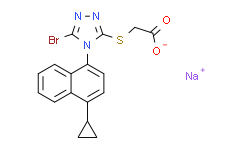| Description: |
Lesinurad sodium is a URAT1 and OAT inhibitor, is determined to be a substrate for the kidney transporters OAT1 and OAT3 with Km values of 0.85 and 2 µM, respectively. |
| In Vivo: |
Lesinurad (RDEA594) shows better pharmacokinetics than its pro-drug RDEA806. The 100 mg dose of Lesinurad exhibits a phamacological effect in the range of that produced by 300 mg to 800 mg single doses of RDEA806[3]. |
| In Vitro: |
Lesinurad is a novel selective uric acid reabsorption inhibitor (SURI). Lesinurad is determined to be a substrate for the kidney transporters organic anion transporter (OAT1) and OAT3 with Km values of 0.85 and 2 µM, respectively[1]. Lesinurad (RDEA594) is a URAT1 and OAT inhibitor, which increases proximal renal tubule urate excretion[2]. Lesinurad (RDEA594) is a potential uric acid lowering agent througn inhibition of uric acid reuptake, and exhibits favorable p450 profiles, inhibits CYP2C9 and CYP2C8 with IC50 of 14.4 μM and 16.2 μM, respectively. IC50s of Lesinurad are all above 100 µM for CYP1A2, CYP2C19,and CYP2D6[3]. |
| Cell Assay: |
Validated oocytes, HEK293, MDCK-II, Caco-2 or MDCK-MDR1 cell systems are used to study the interaction of Lesinurad with membrane transporters localized to the kidney (OAT1, OAT3, OCT2, MATE1, and MATE2K) or liver (P-gp, BCRP, OATP1B1, OATP1B3, and OCT1). Xenopus laevis oocytes are injected with OAT1 or OAT3 cRNA or control (water) while HEK293 cells are stably transfected with MATE1, MATE2K, or vector and MDCK-II cells with hOATP1B1, hOATP1B3, hOCT1, hOCT2, or vector. The MDCKII cell line is stably transfected with the human MDR1 gene to create a P-gp cell line. The interaction of Lesinurad with BCRP relied on the endogenous expression in Caco-2 cells. All cells are cultured with growth medium according to standard methodology. In order to determine whether Lesinurad is a substrate for a transporter, cells are incubated with [14C]-labeled Lesinurad at various concentrations and the amount of Lesinurad taken up by the cells determined by subtracting the uptake in vector cells from that in the transfected cells. The uptake of a [3H]-labeled known substrate of the transporter served as the positive control. Inhibition of a transporter by Lesinurad is determined by incubating cells with a fixed concentration of [3H]-labeled known substrate and various concentrations of unlabeled Lesinurad. Inhibition by a known inhibitor of each transporter served as the positive control. Cells are incubated for the appropriate amount of time. All reactions are terminated by the addition of ice-cold medium. The cells are then rinsed with medium and lysed[1]. |
| References: |
[1]. Shen Z, et al. In Vitro and In Vivo Interaction Studies Between Lesinurad, a Selective Urate Reabsorption Inhibitor, and Major Liver or Kidney Transporters. Clin Drug Investig. 2016 Jun;36(6):443-52.
[2]. Sattui SE, et al. Treatment of hyperuricemia in gout: current therapeutic options, latest developments and clinical implications. Ther Adv Musculoskelet Dis. 2016 Aug;8(4):145-59.
[3]. L.Yeh, et al. RDEA594, a potential uric acid lowering agent througn inhibition of uric acid reuptake ,shows better pharmacokinetics rhan its prodrug RDEA806. 2008 ACR/ARHP Annual Scientific Meeting, 24-29 October 2008, USA. |






















